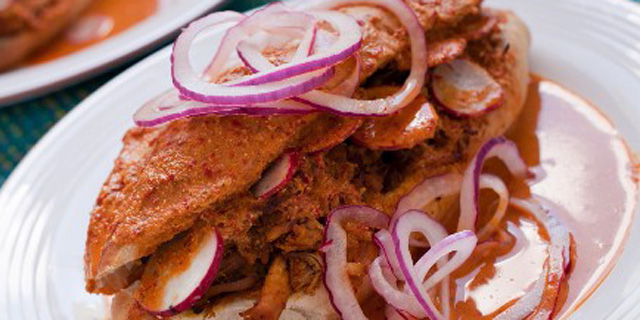1.) Cubano: The Cuban version of a ham and cheese sandwich is believed to have been a common lunch staple among workers at Cuban cigar factories and sugar mills in Cuba in the late 1800’s and eventually adapted in Cuban communities in south Florida. The pressed sandwich combines slow roasted ojo pork (pork marinated in sour oranges, garlic and spices), ham, onions, pickles, Swiss cheese, and mustard.
2.) Cemita: The increasingly popular Puebla born version of a Mexican torta, or sandwich, stuffs a sesame seed egg roll with beef milanesa, pickled pig skin, shredded soft white cheese like quesillo or panela, a papalo, onions, peppers, avocado, and whatever else the cemitero decides to toss in.
3.) Barros Luco: Chile is sandwich obsessed. Junk food shops, many reminiscent of American malt shoppes in the 50′s, can be found all across the country. While the green bean topped chacacero and hot dog topped with avocado, the completo, often get attention, the best-known Chilean sandwich is the Barros Luco. Similar to a Philly Cheese steak, it was named after Chilean president Ramon Barros Luco, who always asked for this sandwich, made of steak and melted cheese. A similar version made with ham instead of steak called the Barros Jarpa, was named after a senator, last name Barros Jarpa.
4.) Pan con Chicharrón: This Peruvian sandwich, a popular breakfast or snack across the country, pairs fried pork with slices of fried sweet potato and salsa criolla, a type of onion relish. Everything is set on a light, crusty French roll. The sandwich is particularly big in Lima’s cafes and sangucherias, such as El Chinito in the center.
5.) Choripán: A favorite Argentine snack, the Choripán, is exactly what it sounds like: chorizo plus pan (bread). Typically the chorizo, here made with beef and pork, is grilled and then split down the middle and placed on a crusty white bread like a marraqueta. Though the choripán was invented in Argenitna, it’s found all over South America including Uruguay, Chile, and Peru. It is usually served with pebre or chimichurri sauces.
[ pagebreak ]6.) Bauru: Brazil’s most famous sandwich isn’t actually from the town of Bauru, rather its inventor was. As the story goes, a student from Bauru that was studying at the Faculdade de Direito do Largo de São Francisco in São Paulo and walked into the student hangout Ponto Chic and specified a hollowed-out French roll with slices of roast beef, melted mozzarella cheese, tomato, and pickles. It became the best selling sandwich at the restaurant, eventually spreading across the country.
7.) Torta Ahogada (above): Born in Guadalajara in the Mexican state of Jalisco the name signifies a “drowned” sandwich because it is literally submerged in a sauce made of chile de árbol. Made with the region’s characteristic birote bread that is topped with pieces of fried pork. It’s served with onions, radishes, avocadoes, and chilies. Order it media ahogada (half drowned) or bien ahogada (really drowned).
8.) Patacón Maracucho: If you like plantains you’ll love this Venezuelan sandwich that replaces bread with green unripe plantains that have been sliced lengthwise, fried, flattened, and fried again. Named after the city of Maracaibo where it was born, it is filled inside with anything from shredded beef to chorizo to cheese. Close relatives include the Jibarito, created at Borinquen Restaurant in Chicago, as well as similar sandwiches in Puerto Rico.
9.) Chivito: When someone requested a sandwich made with baby goat meat, chivito, at a beachfront restaurant called El Mejillon, the owner threw together this mouthwatering combination of sliced beef, ham, olives, eggs, tomatoes, and mozzarella. Now it is the national dish of Uruguay.
10.) Sanduíche de Chola: Served commonly by street vendors in La Paz or as stadium food throughout Bolivia, the “chola” sandwich places slices of roast pork leg, vegetables en escabeche like onions and locoto (rocoto) peppers, and a yellow chile sauce on a large, thick round bun. On top is a peice of crispy pork skin.


![Making Mealtime Matter with La Familia: Easy Sofrito [Video]](https://thelatinkitchen.com/wp-content/uploads/2015/10/sofrito-shutterstock__0-500x383.jpg)
![Easy Latin Smoothies: Goji Berry Smoothie [Video]](https://thelatinkitchen.com/wp-content/uploads/2015/12/goji_berry-shutterstock_-500x383.jpg)
















![Fun and Fast Recipes: Fiesta Cabbage Salad [Video]](https://thelatinkitchen.com/wp-content/uploads/2015/11/fiesta_cabbage_slaw-shutterstock_-500x383.jpg)









